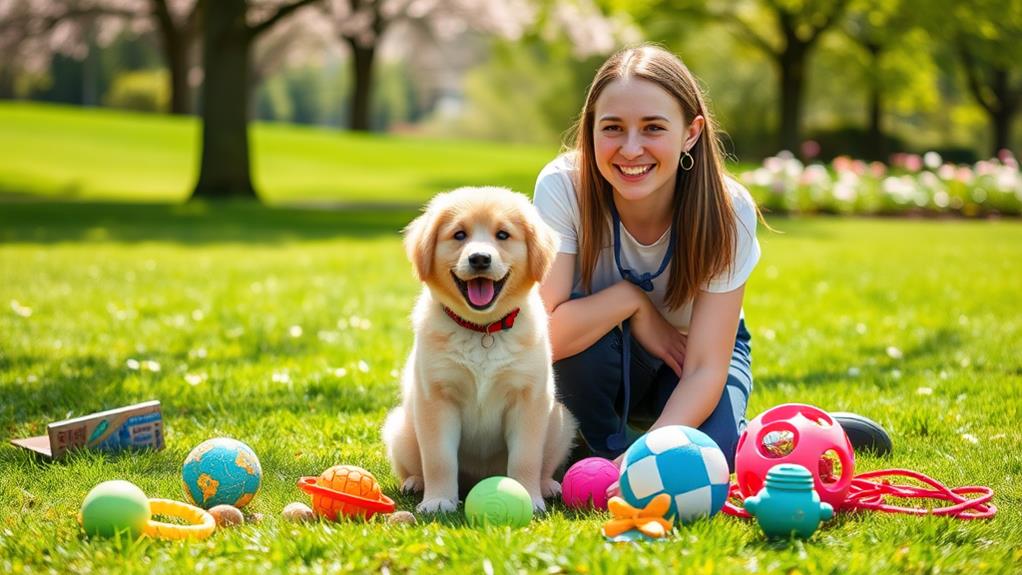Training your dog can be a smooth and enjoyable journey if you follow three essential tips. First, establish consistent commands using simple words like "sit," "stay," and "come." Consistency in tone and body language helps your dog understand you better. Next, use positive reinforcement; reward your dog immediately after they display the desired behavior. This motivates them to repeat it. Ultimately, set realistic expectations based on your dog's age, breed, and temperament. Remember, training is a process where small victories matter. Discovering effective techniques to foster a strong bond with your dog is just around the corner.
Establish Consistent Commands

Establishing consistent commands is essential for effective dog training and helps create clear communication between you and your furry friend. When you use the same words and cues every time, your dog learns what you expect, reducing confusion and frustration for both of you. Choose simple, distinct words for commands like "sit," "stay," and "come." Consistency in your language is key; avoid using different phrases for the same command, as it can hinder your dog's understanding.
In addition to verbal commands, be consistent with your body language and tone. Dogs are perceptive and often respond to your gestures and emotions just as much as your words. If you use a stern voice for "no" and a cheerful tone for "good boy," your dog will quickly pick up on these cues.
Practice these commands regularly in various environments to reinforce their meaning. This will help your dog generalize the commands, making them more reliable in different situations. Remember, patience is indispensable. Training takes time, and your dog will learn better when you're consistent with your commands, creating a strong foundation for a well-behaved pet.
Use Positive Reinforcement

Positive reinforcement is one of the most effective techniques in dog training, and it can make a world of difference in how your dog learns. Instead of focusing on negative behaviors, you'll encourage your dog to repeat the actions you want by rewarding them. This method helps build a strong bond between you and your canine companion.
To use positive reinforcement effectively, always reward your dog immediately after they perform the desired behavior. This can be in the form of treats, praise, or playtime, depending on what motivates your dog the most. For instance, if you're teaching them to sit, offer a treat right after they do it.
Be consistent with your rewards. If your dog doesn't receive a reward every time they perform the behavior, they may become confused about what you expect from them. Also, be mindful of your tone and body language; your dog will pick up on your emotions, which can enhance the training experience.
Set Realistic Expectations

When it comes to training your dog, setting realistic expectations is crucial for both your success and your dog's progress. You might've dreams of a perfectly obedient pup in just a few weeks, but that's often not how it works. Remember, every dog learns at their own pace, influenced by factors like age, breed, and individual temperament.
Start by breaking down your training goals into smaller, achievable milestones. Instead of aiming for an instant transformation, focus on gradual improvements. Celebrate each small victory, whether it's sitting on command or walking nicely on a leash. This approach keeps you motivated and reinforces your dog's learning.
Be patient with yourself and your furry friend. If you encounter setbacks, don't be discouraged; they're a normal part of the training process. Adjust your expectations and remember that consistency and dedication are key.
Lastly, understand that training isn't a one-time event but an ongoing journey. By setting realistic expectations, you'll foster a positive environment conducive to learning and strengthen the bond between you and your dog. Keep it fun, and enjoy the process!
Frequently Asked Questions
How Long Should Training Sessions Last for Puppies?
Training sessions for puppies should last around five to ten minutes. You want to keep their attention, so shorter, more frequent sessions are best. This helps them learn effectively without getting overwhelmed or bored.
What Age Is Best to Start Training a Dog?
Starting training early gives your pup the best chance to shine. Ideally, you should begin around eight weeks old. This age allows their curious minds to absorb lessons, building a strong bond between you both.
Can I Train My Dog Without Treats?
Yes, you can train your dog without treats! Use praise, toys, or playtime as rewards. Consistency and positive reinforcement are key, so keep sessions fun and engaging to encourage your dog's learning and cooperation.
How Do I Handle Distractions During Training?
Distractions can derail training, but you can manage them. Start by choosing a quiet environment, gradually introducing distractions. Use focus exercises to help your dog learn to ignore them, reinforcing attention with praise or toys.
Is It Okay to Train Multiple Commands at Once?
It's generally better to focus on one command at a time. This helps your dog grasp each command fully. Once they've mastered one, you can introduce another without overwhelming them or causing confusion.
Conclusion
In summary, mastering dog training doesn't require a magic wand; it's all about consistency, positivity, and patience. By sticking to clear commands, rewarding good behavior, and setting realistic goals, you'll build a strong bond with your furry friend. Remember, every pup learns at their own pace—just like how we all had to figure out a flip phone back in the day! So stay committed, and soon enough, you'll have a well-trained companion by your side.



